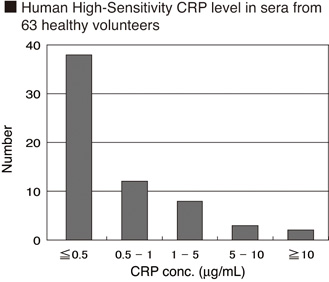CircuLex High-Sensitivity CRP ELISA Kit
| Code | Size | Price |
|---|
| MBL-CY-8071 | 96 Assays | £524.00 |
Quantity:
Prices exclude any Taxes / VAT
Overview
Regulatory Status: RUO
Application: Enzyme-Linked Immunosorbent Assay (ELISA)
Shipping:
4°C
Storage:
4°C
Images
Documents
Further Information
Alternative Names:
C-Reactive protein
Background:
C-Reactive protein (CRP) is a pentameric acute phase reactant that is synthesized by the liver. Its
production is controlled primarily by interleukin-6. The serum CRP concentration may increase by up to
1000-fold with infection, ischemia, trauma, surgery, and other acute inflammatory events (1). Thus CRP
can be used as an extremely sensitive systemic marker of inflammation. Especially in situations where
microbiological diagnosis is difficult or too slow in the clinical context, CRP measurements can be used
to infer the presence of bacterial infection (2).
Ligand-bound or aggregated CRP binds C1q which then activates the classical complement pathway
(3). Although primarily synthesized in hepatocytes, there is evidence for local expression of CRP in
macrophages of the lung and the brain (4?6). In atherosclerotic plaques, it has been found to be
associated with complement proteins and within foam cells (7, 8).
A growing number of studies suggest that CRP is an independent risk factor for atherosclerotic
vascular disease. Plasma CRP concentrations in the highest quartile are associated, depending on the
subject group, with 1.5- to 7-fold increases in relative risk of symptomatic atherosclerosis (1, 9) The
baseline plasma concentration of C-reactive protein predicts the risk of future myocardial infarction and
stroke (10) and is associated with a poor prognosis in unstable angina (11?13).
Plasma CRP levels are also strongly associated with obesity and obesity-related diseases, including
insulin resistance, diabetes mellitus, and hyperlipidemia (14?17). Although a recent report indicated that
the plasma CRP level decreased during weight reduction (17), the precise interaction of CRP with
obesity has not been fully elucidated.
Description:
The CircuLex™ High-Sensitivity CRP ELISA kit is used for the quantitative measurement of Human
C-reactive protein (CRP) in serum, plasma and other biological media.
Gene IDs:
Human: 1401 Mouse: 12944
Kit Components:
Microplate, 10X Wash Buffer, Dilution Buffer, Human CRP Standard, HRP conjugated Detection Antibody, Substrate Reagent, Stop Solution
Measurement Range:
Dilution factors need to be taken into consideration in calculating the Human CRP concentration.
Results exceeding Human CRP level of 9.5 ug/ml should be repeated with diluted samples.
Sensitivity:
better than 28.6 pg/mL of sample.
Target:
CRP
References
1. Westhuyzen J, Healy H. Biology and relevance of C-reactive protein in cardiovascular and renal
disease. Ann Clin Lab Sci. 2000; 30: 133?143.
2. Makayama, T. et al. (1993) Clinical Chemistry. 39(2): 293-297.
3. Du Clos TW. Function of C-reactive protein. Ann Med. 2000; 32: 274?278.
4. Dong Q, Wright JR. Expression of C-reactive protein by alveolar macrophages. J Immunol. 1996;
156: 4815?4820.
5. Gould JM, Weiser JN. Expression of C-reactive protein in the human respiratory tract. Infect Immun.
2001; 69: 1747?1754.
6. Yasojima K, Schwab C, McGeer EG, et al. Generation of C-reactive protein and complement
components in atherosclerotic plaques. Am J Pathol. 2001; 158: 1039?1051.
7. Torzewski M, Rist C, Mortensen RF, et al. C-reactive protein in the arterial intima: role of C-reactive
protein receptor-dependent monocyte recruitment in atherogenesis. Arterioscler Thromb Vasc Biol.
2000; 20: 2094?2099.
8. Tracy RP. Inflammation markers and coronary heart disease. Curr Opin Lipidol. 2000; 10: 435?451.
9. Mendall MA, Patel P, Ballam L, et al. C reactive protein and its relation to cardiovascular risk factors:
a population based cross sectional study. Br Med J. 1996; 312: 1061?1065.
10. Ridker PM, Cushman M, Stampfer MJ, et al. Inflammation, aspirin, and the risk of cardiovascular
disease in apparently healthy men. N Engl J Med. 1997; 336: 973?979.
11. Tomoda H, Aoki N. Prognostic value of C-reactive protein levels within six hours after the onset of
acute myocardial infarction. Am Heart J. 2000; 140: 324?328.
12. Heeschen C, Hamm CW, Bruemmer J, et al. Predictive value of C-reactive protein and troponin T in
patients with unstable angina: a comparative analysis. CAPTURE Investigators. Chimeric c7E3
AntiPlatelet Therapy in Unstable angina Refractory to standard treatment trial. J Am Coll Cardiol.
2000; 35: 1535?1542.
13. Liuzzo G, Biasucci LM, Gallimore JR, et al. The prognostic value of C-reactive protein and serum
amyloid a protein in severe unstable angina. N Engl J Med. 1994; 331: 417?424.
14. Festa A, D?Agostino R, Howard G, et al. Chronic subclinical inflammation as part of the insulin
resistance syndrome. The Insulin Resistance Atherosclerosis Study (IRAS). Circulation. 2000; 102:
42?47.
15. Visser M, Bouter LM, McQuillan GM, et al. Elevated C-reactive protein levels in overweight and
obese adults. JAMA. 1999; 282: 2131?2135.
16. Pradhan AD, Manson JE, Rifai N, et al. C-reactive protein, interleukin 6, and risk of developing type
2 diabetes mellitus. JAMA. 2001; 286: 327?334.
17. Tchernof A, Nolan A, Sites CK, et al. Weight loss reduces C-reactive protein levels in obese
postmenopausal women. Circulation. 2002; 105: 564?569.



